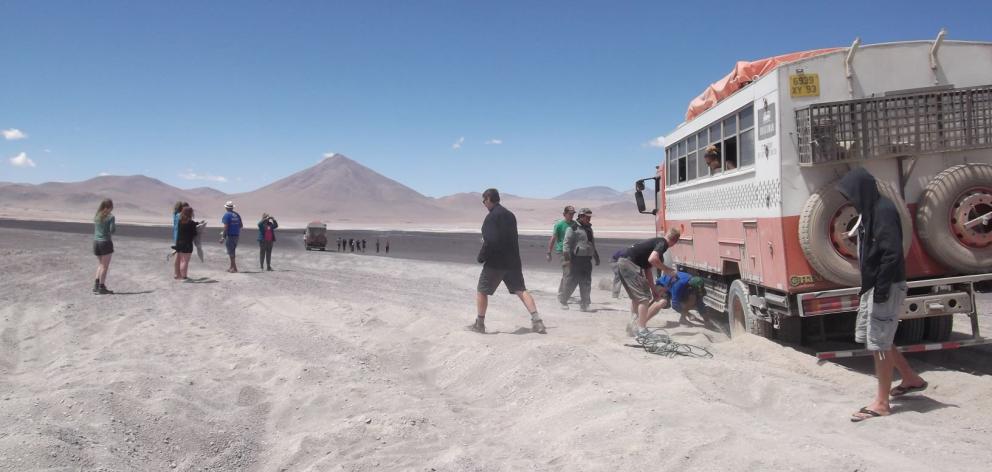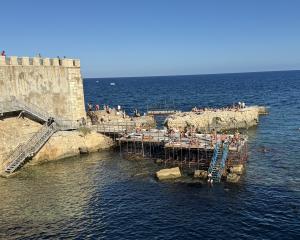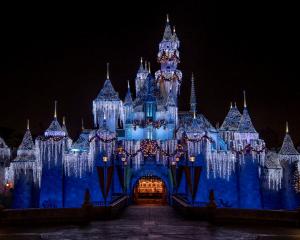
Google Maps has directed us overland from Colombia to Uyuni, Bolivia, with no problem. When it's announced that Pietro, a local guide, will be on board to assist us to cross the Bolivian Altiplano, I wonder why we need help now. I find out soon enough.
We leave the dusty, brown town of Uyuni, where it seems the only colour is in the main plaza's souvenir shops and restaurants, and not long after turn on to a potholed road with no signs masquerading as a highway. Our overland truck bumps, lurches and bounces. It's like an elephant ride over uneven ground. And as slow. Bones jar, flesh wobbles, hands grip seats. It's impossible to read or doze off. The truck we travel in tandem with disappears behind billowing dust, which finds its way into ours, despite closed windows, and settles. Perfect for playing noughts and crosses in on the black tables.
Sometimes "roads'' are little more than tyre tracks. Over the hours the landscape changes. From brown, barren plains dotted sporadically with streams and greenery that looks more like moss than grass, where llamas, alpacas ... or maybe they're vicunas ... graze, to yellow hills with sparse brown tussock grass or knee-high green shrubs, to red-tinged mountains. There are no towns, not even an isolated house, and only one other vehicle appears - with an altitude-sick passenger - on this land that ranges in altitude from 4000m to 6000m. I wonder if the llamas/alpacas/vicunas are wild or belong to somebody somewhere. In the far distance, on lower slopes, there looks to be lines of rocks possibly marking out fields.

In the late afternoon, the monotony of the brown plain is broken by a cluster of towering terracotta-coloured boulders. They stand alone, like a high-rise skyline. Their strange formations - Pietro points out the shape of a condor in one, a parrot in another - have been formed over time by wind-blown sand. Others, that make me feel insect-sized, are split as straight as a ruler by water turning to ice and expanding within the rock centuries ago.
A mini tornado swirls dust across the plain as I board the truck. We drive on, finding more isolated rocks. Wandering among them is like walking narrow roads lined with skyscrapers. I shiver in their shade. We travel further. The sun dips, the wind rises, the temperature plummets.
Around 6pm we reach our stop for the night, a single-level U-shaped building behind a mud-brick wall on a dirt road in what appears to be a deserted, high-mountain village. Strips of meat hang on a line in the brown, dusty courtyard. I guess it's llama or alpaca. After around eight hours of jolting, tiring travelling, I can't be bothered moving off the truck. It takes a while to muster the energy. Or am I putting off finding out what lies inside?

At 6.30am, we're back on the road. There's still no sign of life in the village's mud-brick homes. Packed dirt roads bring us, mid-morning, to look down on to a pristine white lake. The brain takes a while to comprehend - ice ... snow ... salt ...? Nope, it is apparently borax, that substance used in cleaning products. Hopefully, this beautiful scene is never spoilt by mining. Pietro is on the other truck, so I've no idea if we are in the national reserve yet.
Travelling across a vast grey nothingness, I'm rudely jolted from my daydreams as the truck pitches to the left. We've hit deep sand. The left-hand wheels are buried to their rims. It takes around half an hour to dig them clear. Door-sized metal traction things are laid. I hold my breath. I don't want to spend hours ... days ... out here in the dust. Slowly, the truck is manoeuvred upright. Relief.
Laguna Colorada, situated in the Reserva Nacional de Fauna Andina Eduardo Avaroa - created in 1973 mainly to protect flamingos and vicunas, and enlarged in 1981 to cover around 7.5 hectares - is so still it looks like a painting. The shallow lake streaked pink on the foreshore, reflects the sky and surrounding white-splashed, pink and green hills which clouds form shadows on. Flamingos add to the pinkness. A few dead ones, apparently killed by Andean foxes, litter the grey, stony shore, where we also find flamingo eggs surrounded by faded feathers. I wonder where the foxes hide - there's nothing around to conceal them.

Lunch in the sun looking out over the simple hot-spring pool at Termas de Polques, on the shores of Laguna Salada, is enjoyable. There's no wind. A few fellow travellers have a quick soak in the blue water, tiny in the vast pink, white and green-tinged flatness of surrounding land and water. In the distance, pinkish hills rise.
In the late afternoon, we look down on Laguna Verde. The arsenic and copper in the water give it a spectacular bluish-green tinge. Only tyre tracks in the white sand spoil the pristineness.
As darkness descends, we reach the Bolivian border, a grey, square concrete building in the middle of a bleak, windy nowhere. We say goodbye to our guide Pietro and head for Chile and a tarsealed road.
It's been a gruelling journey across a harsh landscape, so vast I often thought how insignificant we humans are. Sometimes I wanted to be anywhere other than on that shuddering, lurching truck, my skin as parched and dusty as the land. But what an unforgettable journey through unforgettable landscape.












